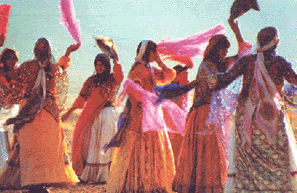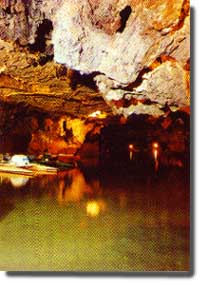Dargazin: in the Razan district of Hamadan province-Azerbaijan
Dargazin: in the Razan district of Hamadan province-Azerbaijan. Population speaks Turkish and belongs to the Shiite Qaragozlu clan.
اهالي درگزين رزن در استان آذربايجاني همدان٬ از طائفه ترك-علوي قاراگؤزلو ميباشند
DARJAZÈN (or Dargazin), name of two rural subdistricts (dehestans) and a village in the Razan district (bakhsh) of Hamadan province. The administrative center for the subdistrict of Upper Darjazin (Darjazin-e olya) is Razan, for Lower Darjazin (Darjazin-e sofla) Famenin. The average altitude of the Razan plain is 1,830 m above sea level, and winters are cold. The chief products of the region are grains, fruits (especially grapes), and dairy products. The village of Darjazin (35° 21' N, 49° 04' E) is situated 83 km northeast of Hamadan in Upper Darjazin subdistrict. The population was 2,825 in 1365 Sh./1986 (Memarian, p. 89).
In the 11th century the Darjazin area was populated by Mazdakites and the related Khorramis (Anushervan b. Khaled, q.v., apud Emad Kateb, p. 114 and Yaqut, Boldan II, p. 569); it was also the native city of an important family of viziers (see Dargazini). In 1032/1622 Shah Abbas I (996-1038/1588-1629) resettled some of the Sunni population of the Baghdad area around Hamadan (Dehgan, pp. 171-72; Krusinski, p. 70). The Ottoman writer Awlia Chelebi (IV, pp. 355-57), who passed through the area in 1065/1654, described the layout of the town and the Moharram mourning ceremonies of the Shiites there and also referred to the garrison and the fort. No trace remains of this fort, which Chelebi associated with the Sasanian king Yazdegerd, possibly referring to Yazdegerd I (399-420). After the Afghan invasion in 1135/1722 Darjazin became the scene of conflict between Persia and the Ottoman empire, changing hands several times (Hazin, pp. 91-93; Marvi, I, pp. 218, 221, 223). In the mid-19th century Zayn-al-Abedin Shirvani (p. 311) reported that the population spoke Turkish and belonged to the Shiite Qaragozlu clan.
Two noteworthy shrines survive at Darjazin. The Emamzada Azhar includes a circular tower with a conical dome 12 m high. A wooden chest in the shrine, part of which has been stolen, bears the date 1056/1646, but the building itself has been dated to the Mongol period. It may be the tomb of Shaikh Salman Aref Dargazini (13th century) or Shaikh Sharaf-al-Din Dargazini (14th century). The Emamzada Hud, situated 3 km west of the Emamzada Azhar near the village of Yengi Qala, is probably the khanaqah (Sufi monastery) of Shaikh Shay-Allah Dargazini (late 14th century). It is a twelve-sided tower 11 m high (Wilber, p. 189, pls. 213-14; cf. Mostafawi, pp. 204-10; Hafez Hosayn, I, pp. 129, 399, 578-79; Nozhat al-qolub, ed. Le Strange, p. 73; cf. Sazman, pp. 228, 301; Dayerat al-maaref, pp. 415, 481-82).
Bibliography:
P. Ad¨kai, Dargazin ta Kashan, Tehran, 1372 Sh./1993.
Awlia Chelebi, Siahat-namasi, ed. A. Jawdat and N. Asem, 6 vols., Istanbul, 1314-18/1896-1900.
Dayerat al-maaref-e tashayyo II, Tehran, 1368 Sh./1989.
E. Dehgan, "Aqalliyatha-ye Eraq ya Sonniha-ye Dargazin," Yagma 7/4, 1333 Sh./1954, pp. 171-73.
Emad Kateb Esfahani, Tarikh dawlat Al Saljuq, Cairo, 1318/1900.
Hafez Hosayn b. Karbalai, Rawzµat al-jenan wa jannat al-jenan, ed. J. Soltan-al-Qorrai, 2 vols, Tehran, 1344-49 Sh./1965-70.
Hazin Lahiji, Tarikh-e Hazin, Isfahan, 1332 Sh./1953.
J. Krusinski, Histoire des revolutions de Perse depuis le commencement de ce sieàcle, Paris, 1742.
Mohammad-Kazem Marvi, Alamara-ye naderi, ed. M.-A. Riahi, 3 vols., Tehran, 1364 Sh./1985.
A. Memarian, Farhang-e dehha-ye Èran. Ostan-e Hamadan, Tehran, 1369 Sh./1990.
M.-T. Mostafawi, Hegmatana, Tehran, 1332 Sh./1953.
Razmara, Farhang V, p. 174. Sazman-e melli-e hefazat-e asar-e bastani-e Èran, Fehrest-e banaha-ye tarikhi o amaken-e bastani-e Èran, Tehran, 1345 Sh./1966.
D. Wilber, Architecture of Islamic Iran. The Il Khanid Period, Princeton, N.J., 1955.
Hajj Zayn-al-Abedin Shirvani, Bostan al-siaha, Tehran, n.d.
(PARVIZ AD¨KAÚÚÈ)



























0 Comments:
Post a Comment
<< Home